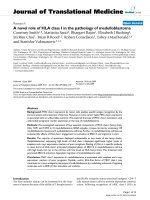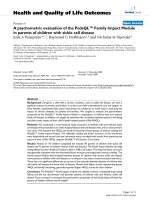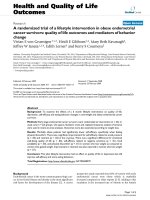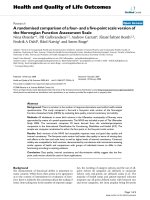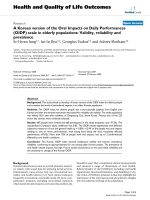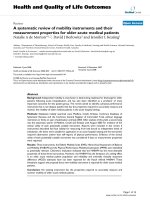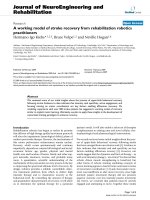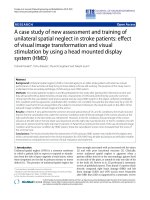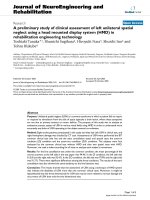Báo cáo hóa học: " A Facile Synthesis of Polypyrrole/Carbon Nanotube Composites with Ultrathin, Uniform and Thickness-Tunable Polypyrrole Shells" ppt
Bạn đang xem bản rút gọn của tài liệu. Xem và tải ngay bản đầy đủ của tài liệu tại đây (1.33 MB, 9 trang )
NANO EXPRESS Open Access
A Facile Synthesis of Polypyrrole/Carbon
Nanotube Composites with Ultrathin, Uniform
and Thickness-Tunable Polypyrrole Shells
Bin Zhang
1
, Yiting Xu
2
, Yifang Zheng
2
, Lizong Dai
2*
, Mingqiu Zhang
1
, Jin Yang
1
, Yujie Chen
3
, Xudong Chen
1*
and
Juying Zhou
1
Abstract
An improved approach to assemble ultrathin and thickness-tunable polypyrrole (PPy) films onto multiwall carbon
nanotubes (MWCNTs) has been investigated. A facile procedure is demonstrated for controlling the morphology
and thickness of PPy film by adding ethanol in the reaction system and a possible mechanism of the coating
formation process is proposed. The coated PPy films can be easily tuned by adding ethanol and adjusting a mass
ratio of pyrrole to MWCNTs. Moreover, the thickness of PPy significantly influences the electronic conductivity and
capacitive behavior of the PPy/MWCNT composites. The method may provide a facile strategy for tailoring the
polymer coating on carbon nanotubes (CNTs) for carbon-based device applications.
Introduction
Over the last two decades, carbon nanotubes (CNTs) have
been widely used as fillers in desirable combinations with
functional polymers because of their high electrical con-
ductivity, chemical stability, low mass density, and large
surface area [1-3]. Composite materials of CNTs and poly-
mers have attracted great interest because they may pos-
sess novel combinations with superior characteristics than
either of the individual components [4-9]. Among them, it
has been already confirmed that the composites consisted
of electronically conducting polymers (ECPs) and CNTs
possess the superior electrical properties than either of the
individual components [8], which are potential materials
for the development of organic electronic devices, such as
organic photovoltaic cells, [10] biologic sensors [11] and
flexible light-emitting diodes [12]. To the best of our
knowledge, the interfacial structure between nanotube and
polymer including the morphology and thickness of
polymer is critical to tailor their structures and properties
in many potential applications [13].
So far, a variety of methods such as chemical oxidation
process, electrochemical or chemical polymerization
through surfactants and template synthesis [14-19] have
been investigated for producing composites from the
combination of CNTs with conducting polymers. Unfor-
tunately, CNTs have often been coated with thick and
nonuniform layers, which r ange from 50 to 80 nm
[14-18], and encapsulated aggregation of CNTs within
the bulk polymer matrix due to the poor solubility of
CNTs and partial exfoliation of nanotube bundles [20].
Moreover, successful results of the PPy/CNT composites
with tunable thickness of the polymer shell have rarely
been obtained [21,22]. The major problem exists in the
processibility of CNTs in solution and the controll of
interfacial bonding in polymer/CNTs composi tes. Due to
the hydrophobic nature and strong van der Waals inter-
actions between CNTs, as-produced CNTs pack into
crystalline ropes and tangle networks which are found to
act as an obstacle to most applicati ons, especially dimin-
ishing the special mechanical and electrical pro perties of
the individual tubes [23]. Furthermore, inherently weak
nanotube-polymer interactions result in the poor interfa-
cial adherent [24], which will lead to the agglomeration
of conjugated polymers. The polymer chains incline to
* Correspondence: ;
1
Key Lab Polymer Composite & Funct Mat, Key Lab Designed Synth &
Applicat Polymer Mat, School of Chemistry and Chemical Engineering, Sun
Yat-Sen University, Guangzhou, 510275, China
2
College of Chemistry and Chemical Engineering, State Key Laboratory for
Physical Chemistry of Solid Surfaces, Xiamen University, Xiamen, 361005,
China
Full list of author information is available at the end of the article
Zhang et al. Nanoscale Research Letters 2011, 6:431
/>© 2011 Zhang et al; licensee Springer. This is an Open Access article distributed under the terms of the Creative Commons Attribution
License (http:/ /creative commons.org/licenses/by/2.0), which permits unrestricted use, distribution, and reproduction in any medium,
provided the original wo rk is properly cited.
form deposits of irregular nanoparticles or sediments
with a diameter of about 50 nm [19,20,23]. Consequently,
one way to overcome these limitations is to control the
polymerization rate of the pyrrole monomers and
improve the processibility of CNTs in solution.
Herein, we report a facile approach to assemble ultra-
thin and uniform PPy films onto multiwall carbon nano-
tubes [MWCNTs] to form a one-dimensional hybrid
nanostructure by an improving in situ chemical oxida-
tion polymerization. The addition of ethanol in the aqu-
eous reaction system is a key point for tuning the
morphology and t hickness of PPy shell by controlling
the polymerization rate [24], which overcomes the sig-
nificant challenge in enhancing the interfac ial bonding
between polymer and carbon nanotubes. The PPy/
MWCNT composites possess the core (individual
MWCNT)/shell (PPy film) structure and no agglomera-
tions or irregular nanoparticles of polymer are found on
the surface of the composites. Furthermore, the synth-
esis process does not need any surfactant assistance and
the thickness of the polymer shell can be precisely con-
trolled by adding ethanol and changing the mass ratio
of PPy/MWCNT. Moreover, the influences of the thick-
ness of coating-polymer on the electrical properties of
the PPy/MWCNT composites have been explained sys-
temically. The r esults can provide the basis for tuning
the polymer thickness to improve the properties of car-
bon-based device.
Results and Discussion
The preparation of the PPy/MWCNT composites based
on a improved in situ chemical oxidation polymerization
method which can be expressed in Figure 1. The surface
modification of MWCNTs was performed with car-
boxylic acid groups yielding MWCNT-COOH. Impor-
tantly, two points should be no ted in the improved
reaction process: 1) The adding sequence of monomer
and initiator is an effective way to achieve polymerization
in the desired locations. The carboxylic acid groups are
likely to offer the interfacial interaction between the poly-
mer and the nanotubes due to the hydrogen bonds
formed between -COOH groups of chemically modified
MWCNTs and NH groups of the PPy [21]. The contact
junctions between MWCNTs and PPy films can be
remarkablely improved by avoiding the use of insulating
surfactants and other organic solutions. 2) The CNTs
easily precipitate into ropes or bundles due to the hydro-
phobic nature and strong van der Waals interactions
between CNTs. So the homogeneous dispersion of nano-
tubes in solution with high surface area is particularly
important. Ethanol is added in aq ueous solution which is
beneficial to well disperse the tubes and stabilize the
MWCNTs to prevent agglomerations or precipitate.
Moreover, ethanol is often used as the free radical col-
lecting agent which exhibits a restraint effect on the poly-
merization reaction. The polymerization rate of pyrrole
monomers is reduced by adding ethanol, this can control
the self polymerization of pyrrole monomers and favor
the even attachment of polymer film on the MWCNTs
surface. It is clea rly shown in the low resolution typical
transmission electron microscopy (TEM) images (see Fig-
ure S1 in Additional file 1), compared with that prepared
without adding ethanol, carbon nanotubes are better dis-
persed and not randomly entangl ed in the PPy/MWCN T
composites by adding ethanol in solution. In additi on,
the surface of the PPy/MWCNT composites appears to
Figure 1 Diagram of synthesis process for PPy/MWCNT composites.
Zhang et al. Nanoscale Research Letters 2011, 6:431
/>Page 2 of 9
be smooth and uniform, and no agglomerations or irre-
gular nanoparticles of polymer are found. The various
ratio of ethanol and acid solution as the reaction solution
significantly influence the morphology of the PPy/
MWCNT composites. The detail of synthesis process is
described in ESM. The PPy films coating o n the surface
ofCNTssynthesizedinthemixedsolutionofV
ethanol
/
V
acid s olution
= 1:1 are smoother and more uniform com-
pared with those obtained in the V
ethanol
/V
acid solution
=
1:5 solution, but the reaction time is prolonged markedly
[24] (TEM images as shown in Figure S2 in Additional
file 1). It proves our conjecture that the ethanol can effec-
tively reduce the polymerization rate of PPy.
TEM image of PPy/MWCNT (2:8) composites is
shown in Figure 2A. The image reveals a coaxial struc-
ture of the resulted PPy/MWCNT composites in which
the MWCNT is encapsulated by a uniform shell of PPy.
Figure 2B shows an high-resolution TEM image of a
segment of MWCNT coated with the ultr athin polymer
shell. The original MWCNT core with a crystalline lat-
tice structure and an amorphous PPy coating layer can
be clearly identified. The MWCNT has an interlayer
spacing of 0.34 nm, which corresponds to the interpla-
nar distance of (002) planes of graphite. Importantly, the
thickness of the PPy is about 6 nm, which reveals the
close interfacial contact between the PPy layer and
MWCNTs [25,26].
Changes in intrinsic polymer propert ies brought about
by the addition of MWCNTs are indicative of nano-
tube-matrix interactions [22]. Improved thermal stability
in polymer/CNTs composites systems relative to the
polymers have been predicted by classical molecular
dynamic simulations [27] . Therefore, thermogravimetric
analyzer measurements of the PPy/MWCNT composites
were carried out, and the results are shown in Figure. 3.
MWCNTs are comparatively stable and showing no
dramatic decomposition, with a 15% mass loss being
observed [21]. However, for pure PPy, two steps r apid
mass loss occurred at around 190°C and 320°C are
depicted by two vertical lines in curve d, which is attrib-
uted to the thermal oxidative decomposition of PPy
chains, and only 20% mass remained for pure PPy at
900°C [28]. For investigating the thermal oxidative
decomposition of PPy/M WCNT composites with differ-
ent shell thickness, two PPy/MWCNT composites were
prepared at the same mass ratio of pyrrole to MWCNTs
(6:4) with (PPy-CNT-1, curve b) and without (PPy-
CNT-2, curve c) the addition of ethanol in the reaction
solution. Two steps rapid mass loss are also observed as
indicated by the vertical lines in curves b and c, respec-
tively [29] These two composites show more delay
decomposition compared to pure PPy. The improved
thermal stability of PPy/MWCNT composites indicates
that there should exist interfacial interaction between
CNTs with polymer shell [21]. Furthermore, it is worth
noting that the temperatures of two steps rapid mass
loss for PPy-CNT-1 composite (curve b ) are increased
from 210°C and 360°C to 280°C and 410°C, respectivel y,
compared with the PPy-CNT-2 composite (curve c). In
contrast, the coa ted-polymer for the PPy-CNT-2 com-
posite is 20 wt.% higher than the former. The reason for
this is given by the TEM i mages of the two P Py/
MWCNT composites (shown in the inset of Figure 3).
Both of the two images reveals a coaxial structure of the
resulted PPy/MWCNT composites in which the
MWCNT is encapsulated by a uniform shell of PPy.
However, the surface of PPy-CNT-1 composite appears
to be smooth and uniform, and there are no agglomera-
tions or irregular nanoparticles o f polymer after a soni-
cated dispersion. Clearly, a lot of irregular PPy particles
and some agglomerations are found when PPy/
MWCNT composite is fabricated without ethanol. The
Figure 2 (A) Typical TEM and (B) HRTEM images of PPy/MWCNT composites (the mass ratio of PPy/MWCNT is 2:8).
Zhang et al. Nanoscale Research Letters 2011, 6:431
/>Page 3 of 9
granular PPy products absorbed on the carbon nano-
tubes surface during the ragid self polymerization reac-
tion of PPy exhibit the weak adherent ability to the
carbon nanotubes. Therefore, ethanol plays an impor-
tant role in restraining the polymerization reaction, con-
trolling the self polymerization of pyrrole monomers,
enhancing the interfacial bonding of polymer/carbon
nanotubes and controlling the morphology of polymer
film on MWCNTs surface.
Raman spectroscopy has also been used to investig ate
the surface and in terfacial properties of P Py/carbon
nanotubes composites [30]. From th e room temperatur e
Raman spectra of (a) MWCNT and (b) PPy/MWCNT
(2:8) composites ( Figure 4), we can see that the typical
peak of pristine MWCNT (Figure. 4a) at 1,591 cm
-1
(G-
band) is attributed to E
2g
mode of graphite wall. The
band at 1,334 cm
-1
(D-band) is assigned to slightly dis-
ordered graphite [30]. Clearly, after the shell coating
forms on MWCNTs surface, four additional Raman
peaks (appeard at around 932, 989, 1,048, and 1,413 cm
−1
, respectively) are found. From the Raman spectra of
pure PPy (inset curve in Figure 4), the bands at approxi-
mately 932 and 989 cm
−1
are assigned to the ring defor-
mation associated with the di-catio n (di-polaron) and
radical cation (polaron), respectively [31]. The band at
approximately 1,413 cm
−1
can be attributed to the C-N
stretching mode and the peak at around 1,048 cm
−1
to
the C-H in plane deformation [32]. The G-band and D-
band of MWCNT clearly change with PPy coating,
demonstrating the interfacial interactions between the
MWCNT and PPy [31]. Interestingly, polaron mode
shifted from in 1,048 cm
-1
of pure PPy to 1,051 cm
-1
of
PPy/MWNT array and the peak intensity increases com-
pared with that of the peak at 989 cm
−1
,andthehigh
frequency C-H in-plane deformation mode at 1051 cm
-1
is correlated with the high electric conductivity of PPy
[32,33]. It is t herefore believed that in our case the
highly conductive PPy/MWCNT composites can be
achieved because the enhanced interaction between PPy
and the MWCNTs surface will be favorable to anchor-
ing the PPy backbone onto the MWNTs surface [34].
Normally, there are significant challenges in tuning
the thickness of the polymer shell, since it is intractable
in processing chemically the synthesized polymer onto
the surface of the carbon nanotubes. Fortunately, an
ultrathin a nd strongly adherent polypyrrole shell grown
on the surface of carbon nanotubes are readily obtained
directly b y our improved method. The morphology and
the thickness of polypyrrole shells were kept nicely in
our reproducible tests, permitting tuning the thickness
of polymer shell by changing the mass ratio of Pyrrole
monomers to MWCNTs. Therefore, the PPy/MWCNT
composites with tunable thickness of polymer shell were
easily fabricated.
Figure 5 presents the TEM images of four PPy/
MWCNT samples prepared with various mass ratios of
PPymonomertoMWCNT.InFigure.5A,itisobserved
that PPy/MWCNT-1, synthesized at a PPy/MWCNT
ratio of 2:8, is composed of ultrathin PPy shell coating on
the surface of MWCNT core. The MWCNT diameter
and PPy thickness are estimated to be around 31.7 nm
and 6 nm, respectively. When the ratios of PPy/MWCNT
were changed to 4:6 and 5:5, the shell thickness of these
two PPy/MWCNT composites are estimated to be
around 15.2 nm and 21 nm, respectively (Figures. 5B and
5C). As the ratio of PPy/MWCNT is raised to 6:4, the
thickness of PPy shell reaches around 28 nm. Moreover,
the surfaces of the four composites are all smooth, uni-
form and free of any granular product [35,36]. It is inter-
esting to note that the thickness of the polymer is not
Figure 3 TGA analysis of PPy, MWNT, and PPy/MWCNT
composites: (a) MWCNT-COOH; (b) PPy/MWCNT-1 composite
prepared by adding ethanol; (c) PPy/MWCNT-2 composite
prepared without ethanol; (d) pure PPy. The insets are the TEM
images PPy/MWCNT-1 and PPy/MWCNT-2, respectively.
Figure 4 Room-temperature Raman spectra of (a) pristine
MWCNT and (b) PPy/MWCNT composite. The inset curve is the
Raman spectrum of pure PPy.
Zhang et al. Nanoscale Research Letters 2011, 6:431
/>Page 4 of 9
increased remarkably as reported in the previous litera-
ture [21] when the mass ratio of the PPy/MWCNT is
changed. The reason may be r elated to the fact that the
polymerization rate of PPy is reduced obviously by add-
ing ethanol in the reaction solution as mentioned above.
Importantly, by using the facile synthesis approach, the
thickness of PPy shell can be controlled by tuning the
mass ratio of PPy monomer to MWCNT accurately,
whichmayprovidethefavorablechoiceforthepractical
synthesis application of conjugated polymer/MWCNT
composites.
A comparison of the X-ray diffraction [XRD] spectra
of different molar mixtures of PPy/MWCNT, MWCNTs
and PPy co mposites are shown in Figure 6. The X-ray
pattern of the MWCNT d isplays the presence of two
peaks at 25.80
°
(3.47 Å) and 42.75
°
(2.12 Å) ass igned to
(002) and (100) diffractions corresponding to the inter-
layer spacing (0.34 nm) of the nanotube and reflection
of the carbon atoms, respectively, in good agreement
with that of the previous literature [37]. For pure PPy, a
broad diffraction peak at 25.4
°
is due to the pyrrole
intermolecular spacing [36]. For the different molar
mixtures of PPy/MWCNT, the XRD spectra show both
the PPy broad peak (at 25.4
º
) and the strong MWCNTs
peaks (at 25.80
°
and 42.75
º
)[21,22].Itisfoundthatthe
intensity of MWCNTs diffraction peaks decreases with
increasing the mass ratio of pyrrole to M WCNTs but is
still stronger than the PPy peaks when th e mass ratio of
pyrrole to MWCNT reaches 6:4.
Furthermore, the electroc hemical properties of the
PPy/MWCNT composites compared with pristine
MWCNTs and pure polypyrrole were evaluated by cyclic
voltammetry test. As shown in Figure S3-A in Additional
file 1 the electrochemical properties of the PPy/MWCNT
composite which the thickness of PPy shell is 6 nm have
been obtained by cyclic voltammetry [CV] with different
scan rates. They all show the typical double-layer capa-
city behavior, which benefited from their large surface
area [38-41]. It can be found that the CV curves of PPy/
MWCNT composite are rectangle-shaped, resulting from
a very quick charging/discharging process in PPy/
MWCNT composite [32]. Compared with the CV curves
of PPy/MWCNT composites, CV curves of both pure
PPy and MWCNTs show lower specific capacitance and
non-rectangle-shape. Thus it can be confirmed that the
electrochemical properties of PPy/MWCNT composites
are superior than those of the individual component PPy
or MWCNT. (Figures S3-B and S3-C in Additional file 1)
[8,42] This can be attributed to the special structure and
morphology of the MWCNT-PPy core-shell composite.
The long-term cycle stability of the PPy/MWCNT com-
posite with the thickness of 6 nm was also evaluated by
repeating the CV test a t a scan rate of 200 mVs
-1
for
1000 cycles. (Figure S4 in Additional file 1) The PPy/
MWCNT electrode exhibits excellent stability over the
entire cycle numbers and maintains 73.6% of its initial
capacity after 1000 cycles, which is consistent with that
reported in the previous literature [38-41]. Swelling and
shrinkage of electrochemically active conducting poly-
mers is well known and may lead to degradation of the
electrode during cycling. This has been overcome by the
core-shell structures, which maybe benefit from the
strong interaction between CNT and PPy [38-41]. After
several 1000 cycles, the interaction force between CNT
and PPy remains unchanged and the PPy shell appears to
have a dense sheet structure, which implies that the
transfer ability of charges remains fairly constant. Hence,
Figure 5 HRTEM images of PPy/MWCNT composites with
different mass ratios of PPy/MWCNT: (A) 2:8; (B) 4:6; (C) 5:5; (D)
6:4.
Figure 6 Comparison of XRD spectra of (a) MWCNTs, PPy/
MWCNT composites with various PPy thickness (nm): (b) 6; (c)
15; (d) 28, and (e) PPy.
Zhang et al. Nanoscale Research Letters 2011, 6:431
/>Page 5 of 9
itcouldbeconsideredthataninterestingsynergistic
effect between MWCNT and PPy plays an important role
in the electrochemical charge-discharge process. Firstly,
the core-shell structure leads to an increase in the surface
area of the PPy/MWCNT composite, which enhances
MWCNTs solubility and dispersibility and improves
effectively the contact with the electrode and electrolyte.
Secondly, the conductivity of the MWNTs dispersed
throughout the structure increases the electrical conduc-
tivity of the composite film over the entire PPy redox
cycle. Thirdly, the ultrathin PPy shell could effectively
shorten the transport path of ion diffusion through the
solid phase and decrease the contact resistance between
the polymer and CNT, which can sign ificant ly improve
the charge transfer ability between the polymer shell and
CNT [8,39]. Therefore, the relationship between the
thickness of PPy and the electrical properties of the PPy/
MWCNT composites should be taken into account. The
specific capacitance values of CNT/PPy composites with
different PPy thickness from 6 nm to 100 nm (including
6, 15, 21, 28, 37, 51, and 100 nm) are presented in Figure.
7A. [Note: In o rder to collect solid data, for every single
sample, we f abricate three electrodes to do the measure-
ments and the average values with error bar are presented
in both Figures 7Aand 6Baccordingly] Clearly, the specific
capacitance decreases linearly as the thickness of polymer
shell increases. However, when the PPy thickness reaches
28 nm, the nonlinear decrease of the specific capacitance
with the increase of PPy thickness is clear. As shown in
Figure 7A, the specific capacitance of the PPy/CNT com-
posites decreases with the increase of PPy thickness and
the trend is intensified when the PPy thichness is thicker
than about 30 nm. Generally, for an ideal electrode mate-
rial, the response current rapidly reaches a steady-state
value due to its high electrical conductivity w hen the
sweep direction of potential is changed, leading to rec-
tangular-shaped CV curves. Hence, the current/ potential
slope at the switching potentials can be used to qualita-
tively reflect a magnitude of the active electrode materi-
al’s conductivity; the steeper the slope, the higher the
conductivity [43]. From Figure 7A, the CV curves are not
rectangle-shaped gradually at a sweep rate of 100 mVs
-1
as the increase of PPy thickness, indicating the resis-
tance-like electroch emica l behavior [35]. In the co nduct -
ing polymer composites, the conductivity depends not
only on the doping level or conjugated length but also on
some external factors such as the compactness of the
sample or orientation of the microparticles [42,43]. Based
on this analysis, the change of the electrical perfo rmanc e
of the PPy/CNT composite may relate to the synergistic
effect of t hese factors aforesaid. Nevertheless, the benefi-
cial effect will reduce with the increase of the ratio of
PPy:CNT. This may be because the thick PPy shell is too
compact to hinder counterions entering into/eje cting
from the PPy films to reach the surface of CNT.
On the other hand , the specific capacitance of electro-
chemical supercapacitor depends strongly on not only
the rates of ionic mass transport but also the series
resistance (R) [34,35,44]. For further understanding the
relationship betwee n the thickness of polymer shell and
electrochemical properties, the resistance of the PPy/
CNT composites are investigated by the electrochemical
impedance spectroscopy [EIS], which is another p ower-
ful tool for mechanistic analysis of interfacial processes
and for evaluation of double-layer capacitance, rate con-
stants, etc [45]. The EIS can be observed as a single and
distorted semicircle in the high-fre quency region and a
near-vertical l ine in the low-frequency region for both
the Nyquist plots. The semicircle portion corresponds
Figure 7 Capacitance values of CNT/PPy composites. (A) Specific
capacitance of PPy/MWCNT composites with different PPy thickness.
The insets are CV curves of PPy/MWCNT composites with various
PPy thickness (nm): 6, 15, 21, 28, 37, 51 and 100 nm in 1 M KCl
solution at scanning rate of 100 mVs
-1
. (B) PPy thickness
dependence of the charge transfer resistance of PPy/MWCNT
composites. The insets are EIS curves of PPy/MWCNT composites
with different PPy thickness.
Zhang et al. Nanoscale Research Letters 2011, 6:431
/>Page 6 of 9
to the elect ron transfer-limited process, whereas the lin-
ear part is characteristic of the lower frequencies range
and represents the diffusion-limited electron-transfer
process [46,47]. It can show all of resistances of superca-
pacitors, which are the electrolyte resistance (R
s
) and the
sum of the electrode itself and the contact resistance
between the electrode and the current collector (R
f
).
The electrolyte resistance and the contact resist ance are
identical under the same test condition. Therefore, an
increase of R
f
indicates an increase of the PPy/CNT
electrode resistance which is represented by the dia-
meter of the semicircle on the Z’ axis in impedance
plots (Z*plots) [43] Based upon this, as shown in Figure
7B, it is clear that the diameters of semicircle of PPy/
MWCNTs composites increase with the increase of PPy
thickness, indicating a clear dependence of charge-trans-
fer resistances on the polymer thickness. Therefore, the
relationship between PPy thickness and electrical prop-
erties of the PPy/CNT composites should include: 1)
Thin PPy shell is facile to enter into/eject cations and
anions. As the PPy thickness increases, the ionic mass
transport becomes slow to reach all the available inter-
faces between PPy and CNT due to the more compact
polymer [34,35]. 2) Compared with Figures 7A and 7B,
for PPy/CNT composites with a thinner PPy shell
(< around 30 nm), the diffusion-limited electron-transfer
process may dominate the electrical properties of the
composite because the electrode itself resistance plays a
major role in the specific capacitance. Like in a metallic
system, the diffusion of the charge carriers is determined
by the band structure around the Fermi energy and
hence, much information about the electronic band
structure of polymer/CNT composite can be obtained
[45], However, when the thickness of polymer is thicker
than 40 nm, other factors such a s the rates of ionic
mass transport and compactness of the sample may
become more important. Thus, the electron transfer-
limited process dominates the electrical properties of
the composites because the electron transfer resistance
of the polymer/CNTs composites increases with the
polymer thickness [45]. Thus, controlling the thick ness
of the polymer coating on the CNTs plays an important
role in functionalizing the CNTs. Furthermore, this
approach could provide a more efficient way for further
researches in the carbon nanotube based composites.
Conclusions
In summary, an ultrathin and uniform polypyrrole (PPy)
film has been successfully coated on MWCNTs through
an improved in situ chemical oxidation polymerization.
The thickness of the polymer can be precisely controlled
by adding ethanol in the reaction system and adjusting
the mass ratio of PPy/MWCNT. The possible mechan-
ism is that ethanol has a pivotal effect on controlling
the degree of self-polymerization of pyrrole monomers
and the morphology of polymer f ilm on MWCNTs sur-
face by restraining the polymerization reaction rate. The
thickness of PPy film has a g reat effect on the electrical
properties of polymer/CNT composites. The facile
synthesis method may provide a very promising candi-
date avenue in controlling the morphology of polymers
coating on carbon nanotubes, especially in fabric ating
the desirable performance of electronic devices.
Methods
Synthesis process
The milled MWCNTs were carefully separated through
200 mesh screen and then functionalized in 2.6 M nitric
acid (HNO
3
) at 80°C for 14 h to get abundant carboxyl
groups at the defect sites and the end of the nanotubes
[48]. Subsequently, the carboxylic acid-functionalized
MWCNTs were thoroughly washed with distilled water
and centrifuged several times until the aqueous solution
reached a neutral pH and left to dry in air. Whereafter,
they were dispersed in the mixed solution with 1 M
HClO
4
solution and ethanol (V
ethanol
/V
acid solution
=1:5)
followed by 10 min of ultrasonication. Pyrrole monomers
were added to the solution and the mixture was vigor-
ously stirred for 30 minutes. The equal molar of ammo-
nium persulfate (APS) dissolved in acid solution was
slowly added to initiate the polymerization a t 0~5°C.
Thismixturewasstirredbymagneticstirringfor8h.At
the end of the reaction, a litte acetone was added to ter-
minate the reaction. Following the typical preparation,
the PPy/MWCNT composites can be prepared with var-
iou s th ickness of PPy shell by changing the mass ratio of
pyrrole monomer/MWCNT.
Characterization
High-resolution microscopy measurements were per-
formed using a JEM-2010HR transmission electron
microscope (TEM) with operating voltage of 120 kV.
Raman spectra were recorded at room temperature uti-
lizing back scattering mode on a Renishaw inVia system.
The 514.5 nm line of an Ar
+
laser was used as the exci-
tation resource. A thermogravimetric analysis [TGA]
was carried ou t in a NetzschTG-209 system. The sam-
ples were scanned from 0 to 900°C at a heating rate of
10°C/min in the presence of nitrogen. Morphology and
microstructure of the as-ob tained composites were per-
formed using X-ray diffraction (XRD, Rigaku D/MAX
2200 VPC, Rigaku company, Japan). The cyclic voltam-
metry was conducted by an electrochemical station (CH
Instruments 660 C, Shanghai Chenhua, China) using
conventional three-electrode conFigureuration with a
platinum sheet as the counter electro de and a saturated
calomel electrode (SCE) as the reference electrode [25] .
The electrolyte containing 1 M KCl dissolved in
Zhang et al. Nanoscale Research Letters 2011, 6:431
/>Page 7 of 9
aqueous solution was deoxygenated under a flow of N
2
for 30 min. The specific capacitance obtained from the
CV curve could be calculated according to t he equation
C=I/sm,where‘ I’ was the avera ge current, ‘ s’ was the
potential sweep rate, and ‘m’ was the mass of each elec-
trode. The composite electrodes were prepared by dis-
persing the PPy/MWCNT composites or carbon
nanotubes, pure PPy samples and PTFE (5%), followed
by adding a small amount of ethanol and NMP to yiel d
a homogenous paste. The paste was spread onto the
nickel foam collectors (1 × 1 cm
2
) and then pressed
under 10 MPa. These electrodes were dried in vacuum
at 60°C for 24 h. Electrochemical impedance spectro-
scopy (EIS) measurements (excitation signal: 5 mV; fre-
quency range: 100 kHz d own to 10 mHz) were carried
out using an IME6X electrochemical workstation.
Additional material
Additional file 1: Electronic Supplementary Material. Word DOC
containing Supplemental Figures S1, S2, S3 and S4
Acknowledgements
Financial support from the program of National Natural Science Foundation
of China (Grant no. 50673104) and Natural Science Foundation of
Guangdong province (Grant no. 7003702) are gratefully acknowledged.
Author details
1
Key Lab Polymer Composite & Funct Mat, Key Lab Designed Synth &
Applicat Polymer Mat, School of Chemistry and Chemical Engineering, Sun
Yat-Sen University, Guangzhou, 510275, China
2
College of Chemistry and
Chemical Engineering, State Key Laboratory for Physical Chemistry of Solid
Surfaces, Xiamen University, Xiamen, 361005, China
3
Institute of Photonics,
SUPA, University of Strathclyde, Glasgow G4 0NW, UK
Authors’ contributions
YX, YZ, LD carried out the synthesis of PPy/CNT composites. BZ, MZ, JY, YC,
XC and JZ carried out the characterization of PPy/CNT composites and
drafted the manuscript.
Competing interests
The authors declare that they have no competing interests.
Received: 5 October 2010 Accepted: 17 June 2011
Published: 17 June 2011
References
1. Pulickel MA, Tour JM: Materials Science: Nanotube composites. Nature
2007, 447:1066-1068.
2. Endo M, Kim YA, Ezaka M, Osada K, Yanagisawa T, Hayashi T, Terrones M,
Dresselhaus MS: Selective and efficient impregnation of metal
nanoparticles on cup-stacked-type carbon nanofibers. Nano Lett 2003,
3:723-726.
3. Heer W, Poncharal P, Berger C, Gezo J, Song Z, Bettini J, Ugarte D: Liquid
carbon, carbon-glass beads, and the crystallization of carbon nanotubes.
Science 2005, 307:907-910.
4. Liu X, Ly J, Han S, Zhang DH, Requicha A, Thompson M E, Zhou C:
Synthesis and Electronic Properties of Individual Single Walled Carbon
Nanotube/Polypyrrole Composite Nanocables. Adv Mater 2005,
17:2727-2732.
5. Wang J, Dai J, Yarlagadda T: Carbon Nanotube−Conducting-Polymer
Composite Nanowires. Langmuir 2005, 21:9-12.
6. Sanghvi B, Miller K, Belcher AM, Schmidt CE: Biomaterials functionalization
using a novel peptide that selectively binds to a conducting polymer.
Nat Mater 2005, 4:496-502.
7. Friend RH, Gymer RW, Holmes AB, Burroughes JH, Marks RN, Taliani C,
Bradley D, Santos D, BreÂdas J, LoÈgdlund M, Salaneck WR:
Electroluminescence in conjugated polymers. Nature 1999, 397:121-128.
8. Ma Y, Cheung W, Wei D, Bogozi A, Chiu P, Wang L, Pontoriero F,
Mendelsohn R, He H: Improved Conductivity of Carbon Nanotube
Networks by In Situ Polymerization of a Thin Skin of Conducting
Polymer. Acsnano 2008, 2:1197-1204.
9. De S, Lyons PSorel, Doherty E, King P, Blau W, Nirmalraj P, Boland J,
Scardaci V, Joimel J, Coleman J: Silver nanowire networks as flexible,
transparent, conducting films: Extremely high DC to optical conductivity
ratios. Acsnano 2009, 3:1767-1774.
10. Janata J, Josowicz M: Conducting polymers in electronic chemical
sensors. Nat Mater 2003, 2:19-24.
11. Zhang D, Ryu K, Liu X, Polikarpov E, Ly J, Tompson M, Zhou C: Transparent,
conductive, and flexible carbon nanotube films and their application in
organic light-emitting diodes. Nano Lett 2006, 6:1880-1886.
12. Xiao R, Choi S, Liu R, Lee S: Controlled electrochemical synthesis of
conductive polymer nanotube structures. J Am Chem Soc 2007,
129:4483-4489.
13. Lee S, Kim B, Chen S, Shao-Horn Y, Hammond P: Layer-by-layer assembly
of all carbon nanotube ultrathin films for electrochemical applications.
J Am Chem Soc 2009, 131:671-679.
14. Chen GZ, Shaffer M, Coleby D, Dixon G, Zhou W, Fray D, Windle A: Carbon
nanotube and polypyrrole composites: coating and doping. Adv Mater
2000, 12:522-526.
15. Hughes M, Shaffer M, Renouf AC, Chen G, Fray D, Windle A:
Electrochemical
capacitance of nanocomposite films formed by coating
aligned arrays of carbon nanotubes with polypyrrole. Adv Mater 2002,
14:382-385.
16. Wu T, Lin S: Characterization and electrical properties of polypyrrole/
multiwalled carbon nanotube composites synthesized by in situ
chemical oxidative polymerization. J Polym Sci B: Polym Phys 2006,
44:1413-1418.
17. Zhang X, Manohar S: Narrow Pore-Diameter Polypyrrole Nanotubes. JAm
Chem Soc 2005, 127:14156-14157.
18. Chen J, Huang Z, Wang D, Yang S, Li W, Wen J, Ren Z: Electrochemical
synthesis of polypyrrole films over each of well-aligned carbon
nanotubes. Synth Met 2002, 125:289-294.
19. Yu Y, Ouyang C, Gao Y, Si Z, Chen W, Wang Z, Xue G: Synthesis and
characterization of carbon nanotube/polypyrrole core-shell
nanocomposites via in situ inverse microemulsion. J Polym Sci A: Polym
Chem 2005, 43:6105-6115.
20. Pumera M, Smíd B, Peng X, Golberg D, Tang J, Ichinose I: Spontaneous
coating of carbon nanotubes with an ultrathin polypyrrole layer. Chem
Eur J 2007, 13:7644-7649.
21. Sahoo N, Jung Y, So H, Cho J: Polypyrrole coated carbon nanotubes:
synthesis, characterization, and enhanced electrical properties. Synth Met
2007, 157:374-379.
22. Viswanathan G, Chakrapani N, Yang H, Wei B, Chung H, Cho K, Ryu C,
Ajayan P: Single-step in situ synthesis of polymer-grafted single-wall
nanotube composites. J Am Chem Soc 2003, 125:9258-9259.
23. Bandyopadhyaya R, Nativ-Roth E, Regev O, Yerushalmi-Rozen R:
Stabilization of individual carbon nanotubes in aqueous solutions. Nano
Lett 2002, 2:25-28.
24. Zhang X, Manohar S: Synthesis of polyaniline nanofibers by “nanofiber
seeding”. J Am Chem Soc 2004, 126:12714-12715.
25. Zhang B, Chen X, Ma S, Chen Y, Yang J, Zhang M: The enhancement of
photoresponse of an ordered inorganic-organic hybrid architecture by
increasing interfacial contacts. Nanotechnology 2010, 21, 065304 (1-7).
26. Mikat J, Orgzall I, Hochheimer H: Raman spectroscopy of conducting
polypyrrole under high pressure. Phys Rev B 2002, 65:174202-174207.
27. Wei C, Srivastava D, Cho K: Thermal expansion and diffusion coefficients
of carbon nanotube-polymer composites. Nano Lett 2002, 2:647-650.
28. Han G, Yuan J, Shi G, Wei F: Electrodeposition of polypyrrole/multiwalled
carbon nanotube composite films.
Thin Solid Films 2005, 474:64-69.
29.
Yang X, Xu L, Ng S, Chan S: Magnetic and electrical properties of
polypyrrole-coated γ-Fe2O3 nanocomposite particles. Nanotechnology
2003, 14:624-629.
Zhang et al. Nanoscale Research Letters 2011, 6:431
/>Page 8 of 9
30. Jun S, Joo S, Ryoo R, Kruk M, Jaroniec M, Liu Z, Ohsuna T, Terasaki O:
Synthesis of new, nanoporous carbon with hexagonally ordered
mesostructure. J Am Chem Soc 2000, 122:10712-10713.
31. Chen B, Li J, Delzeit L, Pei Q: Highly conjugated polypyrrole on
multiwalled carbon nanotube templates analyzed by Raman
spectroscopy. Proc of SPIE 2007, 6423:642312.
32. Orgzall J, Mika I, Hochheimer H: Optical absorption and vibrational
spectroscopy of conducting polypyrrole under pressure. Synth Met 2001,
116:167-170.
33. Robel I, Bunker B, Kamat P: Single-Walled Carbon Nanotube-CdS
Nanocomposites as Light-Harvesting Assemblies: Photoinduced Charge-
Transfer Interactions. Adv Mater 2005, 17:2458-2463.
34. Wang J, Xu Y, Chen X, Sun X: Capacitance properties of single wall
carbon nanotube/polypyrrole composite films. Compos Sci Technol 2007,
67:2981-2985.
35. Feng Z, Li Y, Niu D, Li L, Zhao W, Chen H, Li L, Gao J, Ruan M, Shi J: A
facile route to hollow nanospheres of mesoporous silica with tunable
size. Chem Commun 2008, 2629-2631.
36. Fan J, Wan M, Zhu D, Chang B, Pan Z, Xie S: Synthesis, characterizations,
and physical properties of carbon nanotubes coated by conducting
polypyrrole. J Appl Poly Sci 1999, 74:2605-2610.
37. Endo M, Takeuchi K, Hiraoka T, Furuta T, Kasai T, Sun X, Kiang C,
Dresselhaus M: Stacking nature of graphene layers in carbon nanotubes
and nanofibres. J Phys Chem Solids 1997, 58:1707-1712.
38. Yu Y, Ouyang C, Gao Y, Si Z, Chen W, Wang Z, Xue G: Synthesis and
characterization of carbon nanotube/polypyrrole core-shell
nanocomposites via in situ inverse microemulsion. J Polym Sci Part A:
Polym Chem 2005, 43:6105-6115.
39. Li L, Qin Z, Liang X, Fan Q, Lu Y, Wu W, Zhu M: Facile Fabrication of
Uniform Core-Shell Structured Carbon Nanotube-Polyaniline
Nanocomposites. J Phys Chem C 2009, 113:5502-5507.
40. Yana J, Fan T, Qian W, Zhang M, Shen X, Wei F: Preparation of graphene
nanosheet/carbon nanotube/polyaniline composite as electrode material
for supercapacitors. J Power Sources 2010, 195:3041-3045.
41. Zhou Y, Qin Z, Li L, Zhang Y, Wei Y, Wang L, Zhu M: Polyaniline/multi-
walled carbon nanotube composites with core-shell structures as
supercapacitor electrode materials. Electrochimica Acta 2010, 55:3904-3908.
42. An K, Kim W, Park Y, Choi Y, Lee S, Chung D, Dong J, Lim S, Lee Y:
Supercapacitors using single-walled carbon nanotube electrodes. Adv
Mater 2001, 13:497-500.
43. An K, Kim W, Park Y, Moon J, Bae D, Lim S, Lee Y, Lee Y: Electrochemical
properties of high-power supercapacitors using single-walled carbon
nanotube electrodes. Adv Funct Mater 2001, 11:387-392.
44. Teng H, Chang Y, Hsieh C: Performance of electric double-layer
capacitors using carbons prepared from phenol-formaldehyde resins by
KOH etching. Carbon 2001, 39:1981-1987.
45. Rivadulla F, Mateo-Mateo C, Correa-Duarte M: Layer-by-Layer Polymer
Coating of Carbon Nanotubes: Tuning of Electrical Conductivity in
Random Networks. J Am Chem Soc 2010, 132:37511-3755.
46. Gamby J, Taberna P, Simon P, Fauvarque J, Chesneau M: Studies and
characterisations of various activated carbons used for carbon/carbon
supercapacitors. J Power Sources 2001, 101:109-116.
47. Zhang J, Kong L, Wang B, Luo Y, Kang L: In-situ electrochemical
polymerization of multi-walled carbon nanotube/polyaniline composite
films for electrochemical supercapacitors. Synth Met 2009, 159:260-266.
48. Banks C, Davies T, Wildgoose G, Compton R: Electrocatalysis at Graphite
and Carbon Nanotube Modified Electrodes: Edge-Plane Sites and Tube
Ends Are the Reactive Sites. Chem Commun 2005, 829-841.
doi:10.1186/1556-276X-6-431
Cite this article as: Zhang et al.: A Facile Synthesis of Polypyrrole/
Carbon Nanotube Composites with Ultrathin, Uniform and Thickness-
Tunable Polypyrrole Shells. Nanoscale Research Letters 2011 6:431.
Submit your manuscript to a
journal and benefi t from:
7 Convenient online submission
7 Rigorous peer review
7 Immediate publication on acceptance
7 Open access: articles freely available online
7 High visibility within the fi eld
7 Retaining the copyright to your article
Submit your next manuscript at 7 springeropen.com
Zhang et al. Nanoscale Research Letters 2011, 6:431
/>Page 9 of 9
